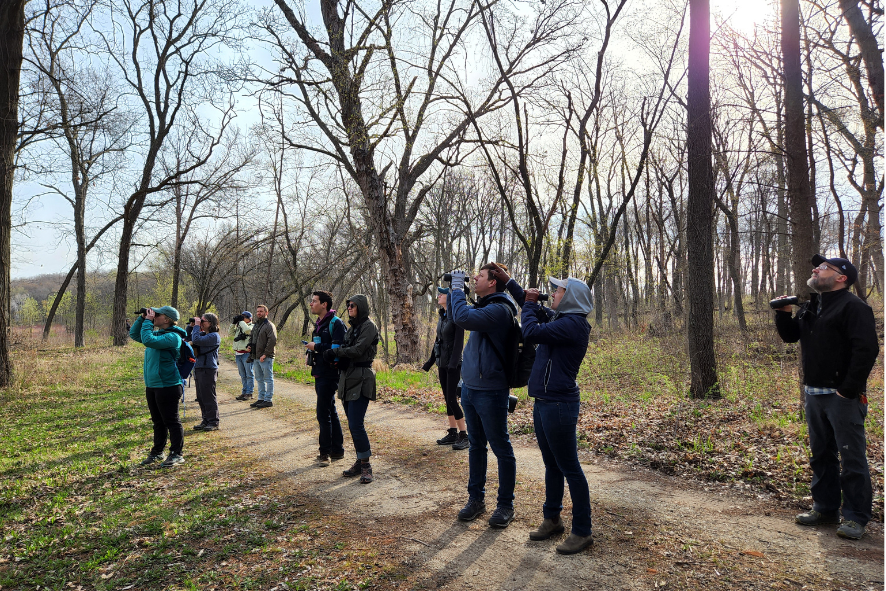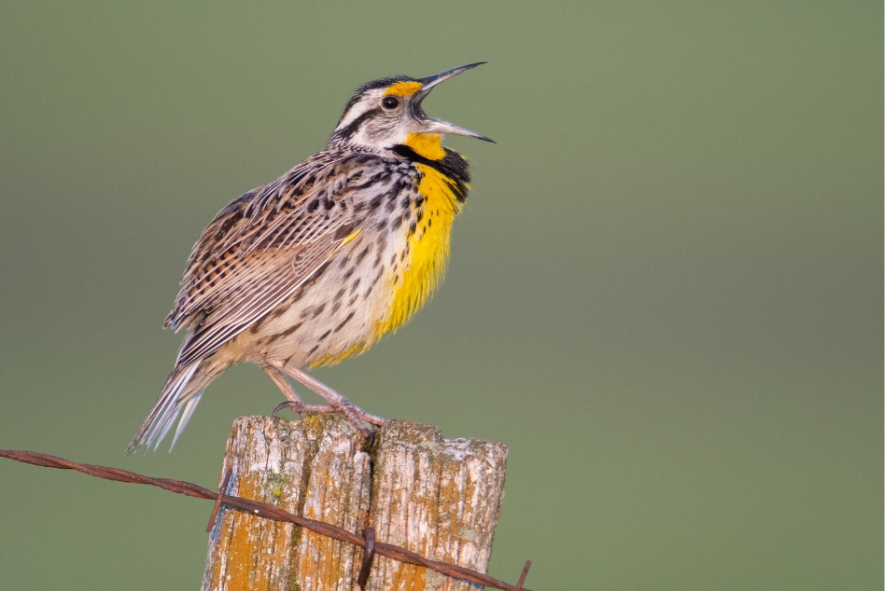Interested in taking up birdwatching (also known as birding) as a hobby? Spring migration is beginning here in Wisconsin, so it’s a great time to get out there. Kim Kreitinger, our resident bird expert (and NRF’s Field Trips Coordinator) has a few tips for new birdwatchers to get you started!

Kim Kreitinger, NRF Field Trip Coordinator, birding at Hudson Park in Madison. Photo by Shelly Torkelson
Birdwatching has been a part of my life for more than 20 years. From the desert scrub and marshland habitats of California to the oak woodlands and prairies of southern Wisconsin, I have watched birds both for work and for fun. It is an important part of my life and helps connect me to the natural world. It sparks my curiosity and provides a sense of community. Here’s some advice for you new birders out there.
New birdwatcher tips
Tip #1: Start easy.
When you begin your birdwatching journey, certain types of birds are better ‘starters’ than others. Starting with Calidris sandpipers may not set you up for success. Birds that are bigger bodied, slow moving, and allow for close viewing are ideal for honing your identification skills. Look no further than waterfowl! Many ducks can be viewed close to shore and have unique identification features that help you easily distinguish the different species. We are fortunate to have a bounty of waterbodies in Wisconsin to begin your waterfowl study.
Check out: Upper Mississippi River National Wildlife and Fish Refuge, Horicon Marsh, Wisconsin Point, Harrington Beach State Park, University Bay (Madison)

Kim Kreitinger birding on the Patrick Marsh boardwalk in Dane County. Photo by Groundswell Conservancy DeBoer Fund
Tip #2: Go birding with experienced birdwatchers.
If you are new to the hobby, it can be a bit overwhelming to go out on a mid-May morning when warblers are dripping from the trees. Trying to determine wingbar presence, leg coloration, or flank streaking while these tiny birds are flitting around the canopies can be a discouraging exercise on your own. But joining an experienced birdwatcher in the field or an organized birdwatching trip can provide some valuable lessons on ID and help boost your confidence. There are many groups throughout the state that offer guided birding excursions led by local experts.
Check out: regional bird clubs, Wisconsin Society for Ornithology, BIPOC Birding Club of Wisconsin, Feminist Bird Club-Madison, and of course, NRF Field Trips!

Members of team Yes We Pelican! representing the Feminist Bird Club-Madison Chapter bird during the 2022 Great Wisconsin Birdathon. Photo by Caitlyn Schuchhardt
Tip #3: Learn bird vocalizations.
Many birds are secretive and difficult to see, and sometimes learning their song or “call notes” is the only way to confirm their presence. Owls, rails, certain sparrows and warblers all fall into this category. Other bird species may look very similar to one another and can only be distinguished by voice. Eastern and western meadowlarks and many Empidonax flycatchers are examples of this. Use online resources to learn the songs of your local birds. When you hear an unfamiliar bird song, take the time to track down that bird. I’ve found seeing the actual bird singing their song helps commit it to memory. You can also associate words or phrases with certain songs, known as mnemonics. “Sweet, sweet, little more sweet” says the yellow warbler.
Check out: Merlin Bird ID app, Cornell Lab’s All About Birds website

An eastern meadowlark calling from a fence post. Photo by Eric Preston, Kim’s husband who shares her love for birding and expresses it through photography!
Tip #4: Get to know your local patch.
You don’t need to drive across the state to see birds. Birds can be found anywhere. I live in a very urban section of Madison not known for an abundance of public greenspace. Housing is dense, yards are small, and parks are few. Yet birds are still all around. My family has recorded 110 species of birds from our (very small) yard. Birding the small city park in my neighborhood, I’ve observed 25 species of warblers in a single morning.
Focusing on the birds in your neighborhood has several advantages. You become tuned in to the seasonal rhythm of birds and nature, also known as phenology. I excitedly anticipate the return of dark-eyed juncos in early November and the white-throated sparrows in April!
Birding your neighborhood will also reduce your carbon footprint and provide exercise. Sometimes you even get to know individual birds. For years the same limping crow visited our peanut feeder, whom we nicknamed Rocky. It’s fun to have a more personal relationship with your feathered neighbors!
Check out: eBird (start a yard or local patch bird list), Wisconsin Green Birding Challenge
I wish you luck on your birdwatching journey. I hope it brings as much joy to you as it has to me. Maybe I’ll see you out on the trail!

Field Trip participants birding on the Mississippi River. Photo by Brad Mueller
Kim’s picks: NRF’s birding Field Trips
Go birding with NRF on a Field Trip! Here are the bird trips that Kim is most excited about this year. She’s also co-leading Biking for Birds in Madison (trip #21) this year.
Shorebirds and waterbirds of Cat Island (#202)
Migration on the Mighty Mississippi (#274)
Bobolink Hill Farm Saunter (#57)
Biking for Birds in Madison (#21)
Go birding for a cause with the Great Wisconsin Birdathon
The Great Wisconsin Birdathon is Wisconsin’s largest fundraiser for bird conservation. Each year bird enthusiasts from across the state form teams with the goal of finding as many bird species as possible within a 24-hour period while raising important funds for bird conservation.
It’s like a walk-a-thon-style fundraiser, but instead of logging miles, you’re logging bird sightings!
Birdathon teams can participate any day from April 15th to June 15th, and all skill levels are welcome to join. Teams can bird anywhere in Wisconsin– a backyard, local park, or a route to hit all their favorite birding hot spots. Both novice and expert birders can have fun and make a difference in protecting birds.
Registration opens on March 15th!